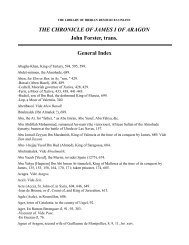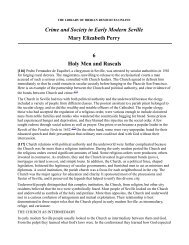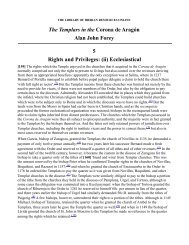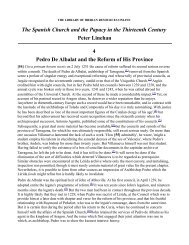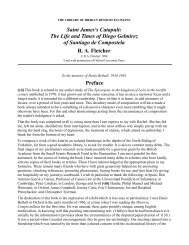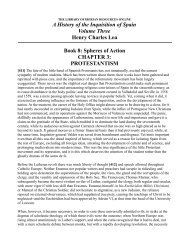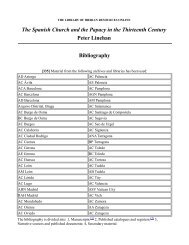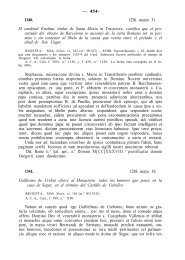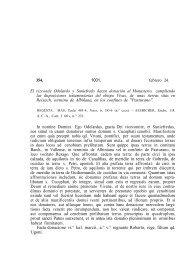Chapter 12 - The Library of Iberian Resources Online
Chapter 12 - The Library of Iberian Resources Online
Chapter 12 - The Library of Iberian Resources Online
You also want an ePaper? Increase the reach of your titles
YUMPU automatically turns print PDFs into web optimized ePapers that Google loves.
This is highly dubious reasoning, and the Arabic etymology gains further support from the presence <strong>of</strong><br />
the form Favara in the Repartimiento and from the appearance <strong>of</strong> the primitive Arabic article Alfavara<br />
in a document <strong>of</strong> 1430. (58) Rascanya is also an arabism, from râs, "head," and canya (from canna,<br />
canal). Here, though, the canal takes its name from the place it irrigates, called Rascayna (cayna, the<br />
diminutive <strong>of</strong> canna) in the Repartimiento. (59)<br />
A repeated canal name in the Valencian region is Algirós (also spelled Aljiros, Algeros, Algiroz). It is<br />
the name <strong>of</strong> one <strong>of</strong> the three major branches <strong>of</strong> the Mestalla system in Valencia and <strong>of</strong> [229] an<br />
important canal near Alcira. Perhaps, too, the canal in Elche called Algorós is related etymologically.<br />
(60) <strong>The</strong> derivation is from al-zurûb, the plural <strong>of</strong> zarb (from zariba, to flow). But in spite <strong>of</strong> the plural<br />
form it has a singular meaning, "the canal," just as almenara is derived from the plural form almanâhir,<br />
"the canals." Even though the canals in question are not now drainage channels, they are<br />
related etymologically to azarbe (from al-zarb) and may originally have served that purpose. (61)<br />
Canals also take their names from other hydraulic expressions. One canal in Gandia is called Ador<br />
(turn), and a secondary channel <strong>of</strong> the Aljufia system in Murcia is called Zarahiche (cistern). (62)<br />
Similarly named are the divisors <strong>of</strong> Elche called Aljupet (little cistern) and El Albellon (drain). (63)<br />
Mills, too, frequently bear hydraulic names. <strong>The</strong> mill <strong>of</strong> Calduf (from alcaduf, by metathesis) on the<br />
Vernisa Canal in Gandia derived its name from the buckets <strong>of</strong> a water wheel. (64) <strong>The</strong> Murcian mill<br />
called Tarquin (65) must have been so named for good hydraulic reasons. Mills create backwaters,<br />
causing a silt deposit through a lowering in the velocity <strong>of</strong> the current.<br />
<strong>The</strong> diversion dam and the canal -- the two most important visible symbols <strong>of</strong> irrigation -- lent their<br />
names to toponyms. Thus a place near Cullera was called El Azut, and the village <strong>of</strong> Burjassot (tower<br />
<strong>of</strong> the dam) in the Valencian huerta on the Moncada Canal similarly took its name from a dam. (66) <strong>The</strong><br />
canal lent its name to a river, the Guadasequies (river <strong>of</strong> the canals). (67) <strong>The</strong> river Cenia, the northern<br />
boundary <strong>of</strong> the kingdom <strong>of</strong> Valencia, took its name from the sâniya, always a popular device in the<br />
province <strong>of</strong> Castellón. (68) Numerous other hydraulic arabisms, notably those derived from springs<br />
('ayn, al-hama) and wells (b'ir) dot the Spanish countryside. (69) One such, <strong>of</strong> more than passing<br />
interest, is Titaguas, a Valencian village near Chelva that takes its name from the Berber tit, "spring,"<br />
plural titduàn or titaguan, easily becoming confused with aguas, which was added as a reinforcement.<br />
(70)<br />
Notes for <strong>Chapter</strong> Twelve<br />
1. See Caro Baroja, "Norias, azudas, aceñas," pp. 60-61.<br />
2. Neuvonen, Arabismos, p. 85. Ramifications <strong>of</strong> the multiplicity <strong>of</strong> channel terms are endless:<br />
Neuvonen quotes a line <strong>of</strong> Arabic which mentions a "canal which is called sâniya and which in<br />
Romance is called calicin [i.e., cauces]." He lists reguera, regadera, and aguaducho as additional<br />
synonyms.<br />
3. Rossi, "Irrigazione nel Yemen," p 356.<br />
4. Jaume Roig, Spill, 11. 14779-14782.<br />
5. José Latour Brotons, Antecedentes de la primitiva Ley de Aguas (Madrid, 1955), p. 45.<br />
6. Ibid., p. 45; Ruiz-Funes, Derecho consuetudinario de Murcia, p. 140; Diaz Cassou, Ordenanzas y<br />
costumbres, p. 63.<br />
7. <strong>The</strong> assigning <strong>of</strong> a different name to each gradation <strong>of</strong> canal in a hierarchical distributory system has




